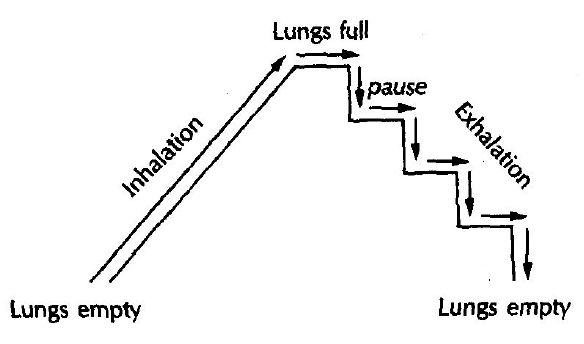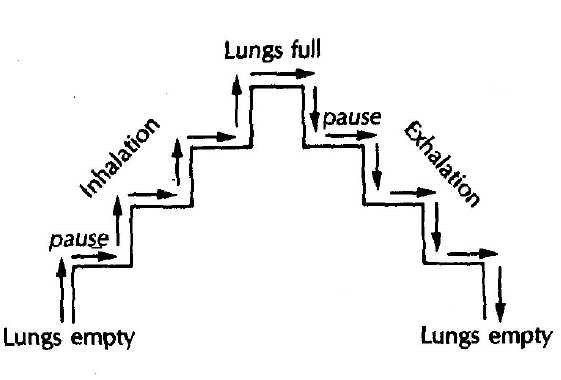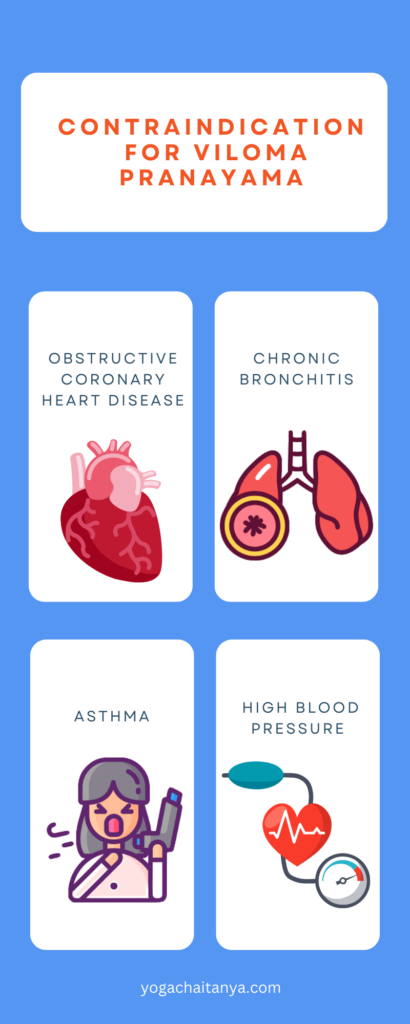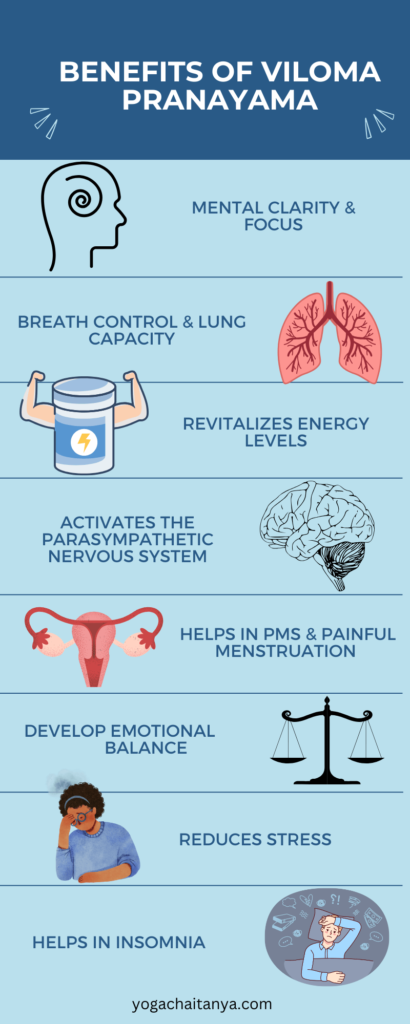Viloma Pranayama the Ultimate Guide for Vitality
-
Written By: Sukhvinder-chaitanya
- Published On:
- Last Updated: December 5, 2024
Are you an athlete, swimmer, or singer, or do you learn any wind instruments?
Are you doing any workouts or aerobic exercise and do you want to increase to breathing stamina?
This complete guide will introduce you to a very simple yet very effective breathing exercise. This simple breathing exercise will strengthen your lungs, increase lung capacity & help you master precise control over your breath.
This is the most comprehensive guide to Viloma pranayama ever. In this guide, you will learn everything you need to know about the practice and implementation of Viloma pranayama in daily life.
By regular practice of Viloma pranayama, many people have healed their physical, mental, and emotional problems. Viloma pranayama helps you to enhance the quality of your life.
As a beginner or an advanced yoga practitioner, you may have questions or difficulties implementing Viloma pranayama. This ultimate guide to Viloma pranayama will provide you with in-depth knowledge of the topic. Here you will learn:
- What is Viloma Pranyama?
- Breath Awareness Exercise.
- Different techniques of Viloma Pranayama.
- Precaution for Viloma Pranayama.
- Contraindication for Viloma Pranayama.
- Who should not Practice Viloma Pranayama?
- Benefits of Viloma Pranayama.
- Common Mistakes to Avoid during Viloma Pranayama.
- How to incorporate Viloma Pranayama into Daily Life?
- Frequently Asked Questions for Viloma Pranayama
This is the most complete guide available on the internet. Let’s dive right in…
Table of Contents
What is Viloma Pranyama?
The Sanskrit word Viloma means against the natural order of things. It is derived from the ancient Sanskrit words “Vi” (against) and “Loma” (hair).
Viloma pranayama is a breathing exercise that involves a series of interrupted inhalations or exhalations with pauses.
In normal breathing, inhalation and exhalation flow smoothly and evenly. Viloma, meaning opposite, here we introduce interruptions in the natural flow of breath.
Viloma Pranyama: The Basics
Before practicing Viloma Pranayama you should understand its fundamental aspects. Here are a few core elements of this breathing technique:
Viloma Pranayama involves conscious interruption and regulation of the natural breath cycle. Unlike regular breathing, where inhalation and exhalation occur continuously and smoothly. In Viloma Pranayama you will introduce pauses and controlled segments within each breath cycle. This practice aims to enhance awareness, mindfulness, and vitality.
The Art of Controlled Breathing (Breath Awareness Exercise)
Before practicing Viloma Pranayama you should be aware of your breath. To practice controlled breathing effectively, follow these steps:
- Find a comfortable seated or lying position.
- Close your eyes and relax your body.
- Inhale deeply and slowly through your nostrils, filling your lungs.
- Watch your breath going in and coming out.
- Do not try to manipulate or alter your breathing pattern.
- Just observe your breath going in and coming out. Be completely aware of your breath.
- Just come in this present moment. Here and Now.
How to practice Viloma pranayama?
Viloma pranayama can be practiced in three techniques, I will explain all of them in detail.
Viloma Pranayama Technique One: Interruption of Inhalation
You can practice Viloma pranayama while Lying down in Shavasana or sitting in any comfortable posture.
Make sure you are awake & aware if you are practicing Viloma pranayama while Lying down in Shavasana.
Relax the whole body and practice breath awareness for a few minutes.
Practice slow, deep breathing with awareness of each inhalation and exhalation. Let the breathing become stabilized.
Visualize an image with a staircase & ramp. (Refer to the Image below)
Visualization will make the practice easier for you.
Imagine that you are breathing up a set of stairs & taking a pause on each step until the lungs are full. Then slowly and smoothly exhale, coming down the ramp until your lungs are empty.

Instructions
Inhale-pause, Inhale-pause, Inhale-pause. Continue in this way until your lungs are full. Exhale slowly and smoothly until your lungs are empty.
This is round one.
The number of steps or interruptions in inhalation will vary for each person depending on the lung capacity, breath control & physical condition of each person. Do not compare yourself with anyone.
Duration of the Practice
You can practice up to 5-10 rounds. Take a normal deep long breath between each round.
Viloma Pranayama Technique 2: Interruption of Exhalation
Now visualize this image with a ramp & a staircase. (Refer to the Image below) Visualization will make the practice easier for you.
Practice in the same way, slowly and smoothly Inhale, coming up the ramp until the lungs are filled. Exhalation is interrupted by a series of pauses until your lungs are empty.

Instructions
Inhale slowly and smoothly until your lungs are full. Now Exhale-pause, Exhale-pause, Exhale-pause. Continue in this way until your lungs are empty. This is round one.
The number of steps or interruptions in inhalation will vary for each person depending on the lung capacity, breath control & physical condition of each person. Do not compare yourself with anyone.
Duration of the Practice
You can practice up to 5-10 rounds. Take a normal deep long breath between each round.
Viloma Pranayama Technique 3: Interruption of Inhalation and Exhalation
This practice combines both interrupted inhalation and interrupted exhalation.
Visualize this image of a staircase going up & then another staircase coming down. (Refer to the Image below) Visualization will make the practice easier for you.
Inhale with a series of pauses until your lungs are full. Then exhale with a series of pauses until your lungs are empty.

Instructions
Inhale-pause, Inhale-pause, inhale-pause. Continue in this way until the lungs are full. Now Exhale-pause, Exhale-pause, Exhale-pause. Continue in this way until the lungs are empty. This is round one.
The number of steps or interruptions in inhalation will vary for each person depending on the lung capacity, breath control & physical condition of each person. Do not compare yourself with anyone.
Also, note that the number of steps in inhalation & exhalation will not be equal. Exhalation will always have more steps in comparison to inhalation because of residual air in the lungs.
Duration of the Practice
You can practice up to 5-10 rounds. Take a normal deep long breath between each round.
Precaution for Viloma Pranayama
1) Do not strain or create any discomfort while breathing.
2) Do not force your breath during the last inhalation & exhalation.
Contraindication for Viloma Pranayama
Who should not Practice Viloma Pranayama?
1) Do not practice Viloma Pranayama if you are suffering from Obstructive Coronary heart disease.
2) People suffering from Chronic bronchitis or asthma should avoid this pranayama.
3) Do not practice Viloma Pranayama if you are a High blood pressure patient.

Join our unique 200 hour yoga teacher training India courses and programs for a transformational and life-changing experience. Yoga Chaitanya International Institute offers 200 hour yoga training Course in India at Goa (close to the beach) and in Dharmshala, (close to the Himalayas). Yoga Chaitanya is an emerging destination for yoga and meditation students. Book Now!
Start your Yoga Journey to Transform your Life !
What are the Benefits of Viloma Pranayama?
Benefits of Viloma Pranayama
1) Viloma Pranayama Improves breath awareness and concentration. Further increasing mental clarity and focus. The practice of Viloma Pranayama sharpens your mental faculties. The controlled breath interrupts the mind’s chatter and enhances concentration. Enabling you to approach tasks with a clear and focused mindset.
2) Regular practice of Viloma Pranayama Increases breath control and lung capacity. This technique encourages deep inhalations, which, over time, will strengthen your respiratory system, Further, improving overall lung function. If you are an athlete, swimmer, singer, or wind instrument learner then you must practice this pranayama.
3) Practice of this pranayama removes residual stale air from the lungs and, increases the concentration of oxygen & prana in the body. This revitalizes your energy levels, making you feel more vibrant and alive.
4) This pranayama increases the awareness of the practitioner towards breath modulation and breath control. Thus it is an excellent preparation for Nadi Shodhana, bhastrika, kapalbhati, and other pranayamas.
5) Interrupted breathing during Viloma Pranayama improves pulmonary activity and activates the parasympathetic nervous system. Thus it has a calming effect on the mind and body. Viloma Pranayama reduces stress, anxiety, fatigue, and insomnia.
6) Viloma Pranayama is also helpful in PMS. If the menstruation is painful then practice this pranayama while lying in Savasana, otherwise, you can practice it in any comfortable sitting position.
7) Regular practice of Viloma Pranayama helps to develop emotional balance. Viloma Pranayama aids in a sense of calmness and balance. It allows you to step back from intense emotions.

Common Mistakes to Avoid during Viloma Pranayama
Viloma Pranayama is a transformative practice, but it’s essential to be mindful of a few potential pitfalls:
- Overexertion: Avoid forcing your breath or holding it for too long. Maintain a comfortable rhythm.
- Shallow Breathing: Ensure your breaths are deep and complete, reaching the diaphragm.
- Lack of Focus: Stay mentally present throughout the practice. Let go of your distractions and bring your attention and awareness to your breath.
How to incorporate Viloma Pranayama into Daily Life?
Make sure you integrate Viloma Pranayama into your daily routine. Consistent practice will help in getting maximum benefits. To make Viloma Pranayama a part of your daily life, consider the following:
- Morning Routine: You should begin your day with a few minutes of Viloma Pranayama to set a positive tone.
- Midday Break: Take a few short breaks during the day. During these short breaks practice Viloma Pranayama and re-energize yourself.
- Evening Relaxation: Make a ritual to unwind in the evening with Viloma Pranayama. De-stress yourself and prepare for restful sleep.
Frequently Asked Questions about Viloma Pranayama
How often should I practice Viloma Pranyama?
As a beginner, you should practice Viloma Pranayama for 10-15 minutes daily. Regular practice is key to experiencing the full benefits of Viloma Pranyama.
Can Viloma Pranyama help with anxiety?
Yes, Viloma Pranyama acts as an effective tool for managing anxiety. It has a calming effect on the nervous system, further, it reduces stress levels.
Is Viloma Pranyama suitable for beginners?
Absolutely Yes, Viloma Pranayama is suitable for beginners. The practice Viloma Pranayama prepares beginners for advanced breathing practices.
Can I practice Viloma Pranyama during pregnancy?
Pregnant women should consult with a doctor before practicing Viloma Pranayama to ensure safety.
How does Viloma Pranyama improve concentration?
When we are practicing Viloma Pranayama our complete awareness and concentration are used to get precise control of our breath to create a step sequence of breath. Further, it enhances oxygen flow in the brain, improving focus and concentration over time.
Are there any precautions I should take while practicing Viloma Pranyama?
Yes, there are a few precautions and contraindications for practicing Viloma Pranayama. Avoid practicing Viloma Pranyama in extreme temperatures or if you are feeling unwell. Do not strain or create any discomfort while breathing. Listen to your body and practice with care.
If you are suffering from obstructive coronary heart disease, chronic bronchitis, asthma, and high blood pressure then you should avoid it.
Conclusion
Incorporating Viloma Pranayama into your daily life can have transformative effects on your well-being. This breathing technique offers a path to a balanced and harmonious existence. Explore Viloma Pranayama, commit to regular practice, and embrace a healthier life.
So, try incorporating Viloma Pranayama into your daily yoga practice and see the results.
I hope you liked this post. Now I would like to hear from you. What did you think of today’s post?
Or maybe if you have a question about Viloma Pranayama. Let me know by leaving a comment below.
Yoga Chaitanya International Institute is one of the leading Yoga Teacher Training schools in India. Our unique courses and programs give a transformational life-changing experience.
Join our 200 Hour Yoga Therapy Teacher Training program. It is carefully designed using an integrated approach to yoga, meditation, Ayurveda, and other alternative healing practices.
Start your Yoga Journey to Transform your Life !

About the Author: Sukhvinder Singh Chaitanya
Sukhvinder Singh (Chaitanya) is an experienced yoga teacher. (ERYT-500 & YACEP with 20,000+ hours of teaching experience) He is a master yoga teacher in Ashtanga Vinyasa Yoga, Vinyasa Flow, Hatha Yoga, Yin Yoga, Iyengar Yoga, Ayurveda & Laughter Yoga. He has been teaching yoga, laughter yoga & meditation all across the globe in teacher training programs, workshops & corporate sector for almost 10 years. He's the founder and director of the Yoga Chaitanya International Institute, a leading Yoga Teacher Training school in the world. He shares his expertise in his blogs and his YouTube Channels.
